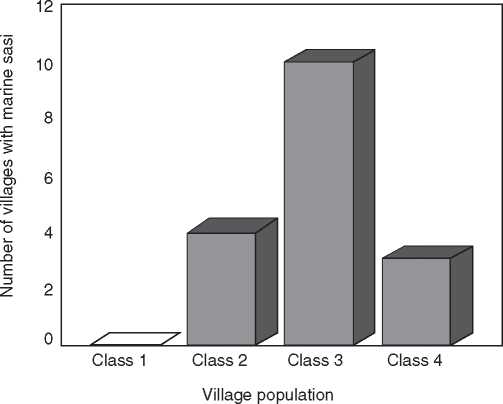Village, land and marine sasi occurred in every possible combination. In 11 villages, sasi
covered all three areas i.e., the village, land crops and marine resources. In 16 cases, sasi rules
were operating in two of the three locations. Marine sasi occurred by itself in one village,
whereas land sasi occurred by itself in 15 villages. In four Ambonese Muslim villages, there
was only village sasi. Village sasi involves rules that mostly regulate social conduct and are
applied within the village. It is significantly more common in Muslim villages and on the
island of Haruku (Table 7.4), but is absent from Nusa Laut Island. We will not discuss this
form of sasi in any detail. Rather, we will focus on the 43 villages where the institution included
rules related to land and/or marine resources.
7.1.2 Distribution of sasi on land crops and marine resources
Sasi applied to land crops occurred in 41 villages (Table 7.4). Occurrence varied with religion
and island, being most common in Christian villages and on Haruku and Nusa Laut.
Only 17 villages had marine sasi. In two other villages, one or more fishermen claimed that
there was sasi on certain species, but this was not confirmed by village leaders. The institution
occurred equally in Muslim and Christian communities but its distribution varied significantly
with population, being most common in Class 3 villages (2,001-3,000 persons) and absent
from Class 1 (1,000) (Figure 7.1). The occurrence of marine sasi also varied significantly from
island to island, being most common on Seram and Saparua (over 50% of villages sampled on
each of these islands had marine sasi) and least common on Ambon (9%). The small sample
on Seram is not necessarily representative of the whole island. The sample on Ambon is
certainly an over-estimate, as the sample excluded suburban and urban satellite villages. On
Nusa Laut, there was no marine sasi at all, but until recently, the villagers there still maintained
a practice of communal fish harvesting called sousoki.

Figure 7.1. Distribution of marine sasi in villages of various
sizes. Class 1= population ≤1,000; Class 2= 1,001-2,000;
Class 3= 2,001-3,000; Class 4= >3,000.
Result of The Inventory of Sasi 67
More intriguing information
1. The name is absent2. The Complexity Era in Economics
3. Learning and Endogenous Business Cycles in a Standard Growth Model
4. A Dynamic Model of Conflict and Cooperation
5. The name is absent
6. WP RR 17 - Industrial relations in the transport sector in the Netherlands
7. The name is absent
8. Proceedings of the Fourth International Workshop on Epigenetic Robotics
9. News Not Noise: Socially Aware Information Filtering
10. A Location Game On Disjoint Circles